- EBMS Knowledge Base
- Inventory
- Serialized Items | Purchasing or Manufacturing an Item
-
Client Resources
-
EBMS Main Documentation
- Introduction
- Getting Started
- Getting Started | Initial Installation
- Getting Started | Company Setup
- Quick User Guide | Financial Staff | Accountant
- Quick User Guide | Financial Staff | Accountant | Accountants Journal
- Quick User Guide | Sales Staff
- Quick User Guide | General Staff
- Features
- Reports
- Security
- Server Manager
- Technical
- Technical | Data Import and Export Utility
- Technical | SQL Mirror
- Automotive
- Automotive | Parts Catalog
- Automotive | Pricing
- Automotive | Point of Sale
- Automotive | Product Application
- Automotive | Keystone Interface
- Metal Supply
- Fuel Sales
- Horticulture
- Horticulture | Farm Setup
- Horticulture | Processing Payroll
- Horticulture | Managing the Farm
-
Sales
- Introduction
- Customers
- Customers | Miscellaneous Customers
- Proposals
- Proposals | Processing Proposals
- Proposals | Sets and Templates
- MyProposals
- MyOrders
- Sales Orders
- Invoices
- Materials Lists
- Sales and Use Tax
- Sales and Use Tax | TaxJar
- CRM
- CRM | Auto Send
- Recurring Billing
- Credits
- Customer Payments
- Payment Card Processing
- Payment Card Processing | Gift Cards
- Payment Card Processing | Loyalty Cards
- Payment Card Processing | Verifone Gateway
- Freight and Shipping Tools
- General Ledger Transactions
- Point of Sale
- Point of Sale | Point of Sale Hardware
- Point of Sale | Xpress POS System
- Point of Sale | Advanced Tools
- Signature Capture
- Salesperson Commissions
-
Inventory
- Product Catalog
- Product Catalog | Using Product Codes for No Count Items
- Product Pricing
- Product Pricing | Special Pricing
- Tracking Counts
- Unit of Measure
- Purchasing
- Special Orders and Drop Shipped Items
- Receiving Product
- Barcodes
- MyInventory and Scanner
- Components (BOM) and Accessories
- Components (BOM) and Accessories | Component Formula Tool
- Made-to-Order Kitting
- Configure-to-Order Kitting
- Multiple Inventory Locations
- Multiple Inventory Locations | Creating Locations
- Multiple Inventory Locations | Using Multiple Locations
- Multiple Inventory Locations | Product Catalog Sync
- Multi-Vendor Catalog
- Serialized Items
- Serialized Items | Purchasing or Manufacturing an Item
- Serialized Items | Selling and/or Associating an item with a customer
- Lots
- Product Attributes
- Product Attributes | Selling and Purchasing Items with Attributes
- Product Attributes | Custom Attributes
- Mobile Scanner (Legacy)
-
Labor
- Getting Started
- Workers
- Taxes and Deductions
- Work Codes
- Time and Attendance
- Time and Attendance | Time Track App
- Processing Payroll
- Closing the Payroll Year
- Processing Payroll - Advanced
- Salaried Pay
- Piecework Pay
- Direct Deposit
- 3rd Party Payroll Service
- Subcontract Workers
- Flag Pay
- Prevailing Wages
- MyDispatch
- MyTasks
- MyTime
- MyTime | Communications
- MyTime | Setup
- Tasks
- Tasks | Getting Started
- Tasks | Creating Tasks
- Tasks | Scheduling Tasks
- Tasks | Customizing Task Views
- Tasks | Managing Tasks
-
Financials
- Introduction
- Fiscal Year
- Chart of Accounts
- Budget
- Financial Reporting
- Transactions and Journals
- Transactions and Journals | Journals
- Account Reconciliation
- 1099
- Departments and Profit Centers
- Fund Accounts
- Bank Accounts
- Bank Feed
- Vendors
- Vendors | Miscellaneous Vendors
- Purchase Orders
- Expense Invoices
- Vendor Payments
- AP Transactions
- Landed Cost
- Fixed Assets and Depreciation
- Fixed Assets and Depreciation | Fixed Assets
- Fixed Assets and Depreciation | Fixed Assets | Adding Assets
- Fixed Assets and Depreciation | Processing Depreciation
- Fixed Assets and Depreciation | Disposing Assets
- MyJobs
-
E-commerce
-
Rental
-
Job Costing
-
Manufacturing
Made-To-Order Serialized Items
Serialized items are often used within a Made-To-Order (MTO) environment so that individual records are created for each item. An inventory item classified as Serialized Items is useful for a wide variety of items that may not contain a specific serial number but need to be tracked after the sale. Manufactured equipment, storage sheds, or other items can be uniquely identified using a code or number generated during manufacturing for warranty purposes or other future repairs or changes. Review the Creating a Serial Number for more information on generating serial numbers.
Launch the new inventory wizard and select the target folder for the new kit. Click Next to enter the Description as shown below.
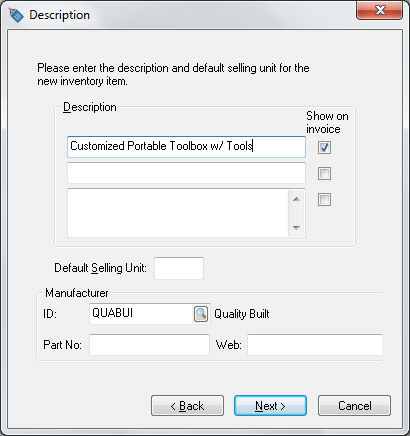
Click on the Next button to continue.

Set the Classification option to Serialized Items and enable the Made to Order option.
Enter the Gross Weight, Tax Group settings if applicable and click Next.
Enter the Pricing Information or any additional information.
Enter the Item Code on the last page of the wizard and enable the I want to view the new inventory now option.
Click on the Finish button to open the inventory Item.
Click on the Components tab as shown below:
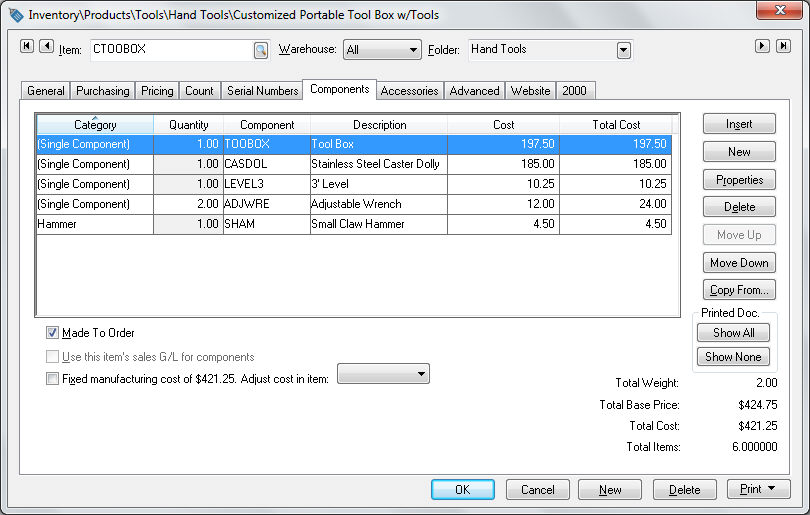
List the parts of the made-to-order portable tool kit into the Components tab. Enable the Assembly Kit option. Review the Inventory > Components > Adding Components to Create an Assembly Kit for more details on adding components to an assembly.
The serial number entry dialog will open when the MTO serialized item is entered into the sales order if the Select serial number or lot while the item is entered option is enabled. Go to Sales > Options > Invoices and S.O.s tab to view or set this option as shown below:
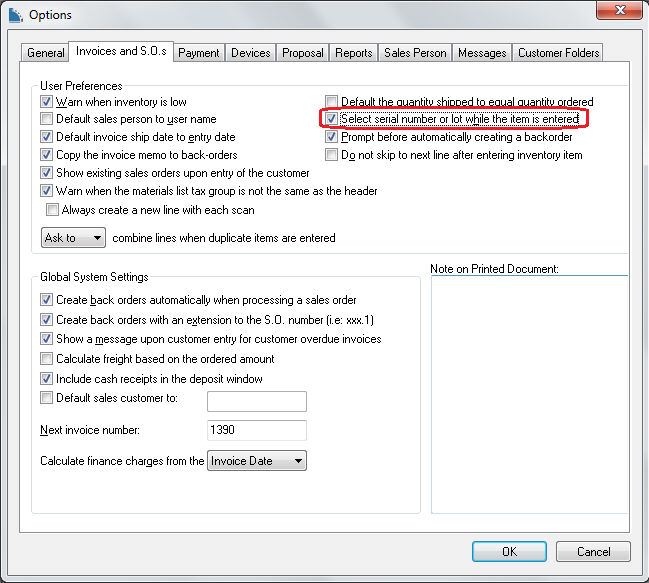
Review the Made-to-Order Kitting > Overview of the MTO Process and the Made-to-Order Kitting > Inserting a MTO item into a Sales Order sections of the Made-to-Order Kitting section of this manual for details on inserting a MTO item into a sales order or invoice.
Right-click on the serialized item and select Serial Numbers from the context menu as shown below:
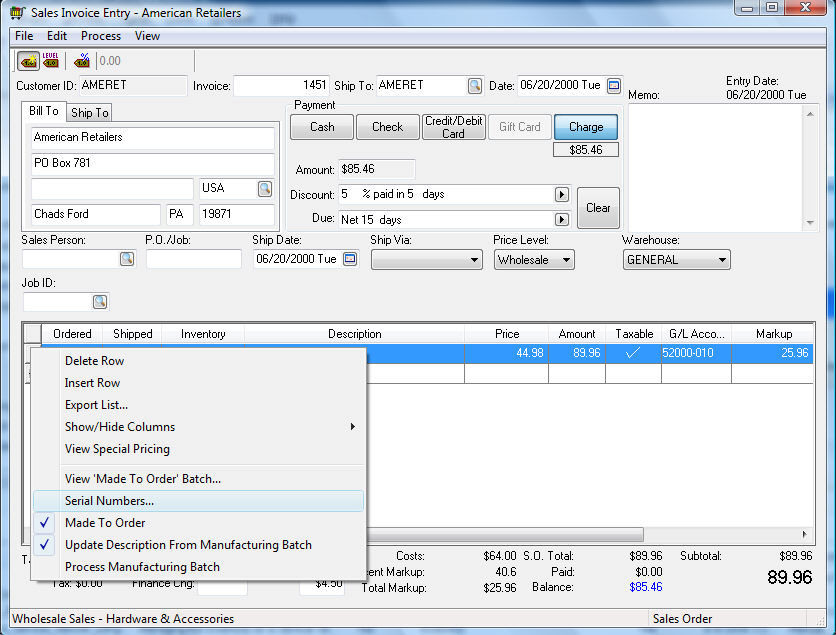
Enter the appropriate serial number for each new serialized item.
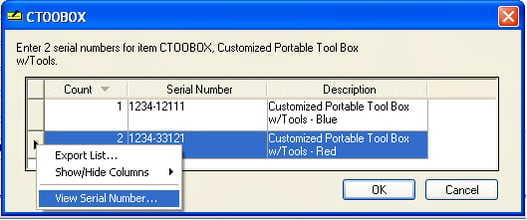
The Description of individual items can be changed within this dialog. Other details can be entered into the individual serial number records by right-clicking on the serial number line and selecting View Serial Number as shown above. Review the Purchasing Serialized Items section for more details on entering serialized item details.
An MTO serialized item will be added to a customer record when the sales order is processed in the same manner as serialized items that are selected within the sales invoice window.
